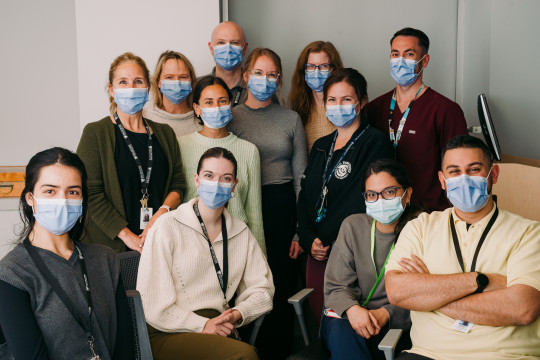Together with Dalhousie University, IWK Health is home to the largest and longest running vision sciences program in North America—and soon to be the only one in Canada. Not only is it the largest, but it’s also the only dual-streamed orthoptics and ophthalmic medical technology program, and the only one offering a masters level of certification. The program began as the School of Orthoptics and Ophthalmic Medical Technology at the IWK in 1984. Then in 2003, the IWK partnered with Dalhousie University to implement the unique, and highly competitive, Clinical Vision Sciences program offered today.
Orthoptics is a crucial clinical service, and one the IWK excels at with its prestigious training and 10 permanent orthoptists on staff. But what is it exactly?
“That is a question we often get asked,” says Leah Walsh, orthoptist, ophthalmic medical technologist and adjunct professor. “An orthoptist is an eye care professional that specializes in the diagnosis and non-surgical management of ocular disorders such as strabismus and amblyopia. Orthoptists provide valuable information about a patient’s binocular status and the integrity of the oculomotor system.”
At the IWK, orthoptists’ work involves a combination of clinical, academic and administrative duties. Orthoptists are keen critical observers whose evaluation begins before the patient even enters the examination room. They watch for facial and/or body asymmetry, an anomalous head position, and look for obvious gait or motor coordination issues. Orthoptists treat patients of all ages that struggle with double vision, vision issues not corrected with spectacles, ocular misalignment (eye turn) or issues with the way the eyes work together.
Orthoptists see practically all patients that come into the IWK’s Eye Clinic and depending on the patient’s needs, orthoptists work with, or independently of, ophthalmologists. This allows for more targeted treatment, helping to keep waitlists to a minimum. As part of their daily work, orthoptists can run and interpret an almost-endless list of tests. They can fit prisms on glasses for people with double vision. Two members of the team are specialists in pediatric contact lens fitting. Some members work in the electrodiagnostic lab. Orthoptists are also the primary caretakers for patients with amblyopia—a condition when the brain chooses a “favourite” eye, leading to decreased vision.
“I like to think that my job as an orthoptist is like putting together a jigsaw puzzle,” says Jessica Carr, orthoptist, ophthalmic medical technologist and adjunct professor. “We gather the pieces of information and, together with our ophthalmologists, help to put them together to create the big picture about the patient sitting in our chair. Orthoptics is a fantastic profession—though I may be biased!”
“We are not just the test doers,” says Walsh. “We interpret the results, formulate, and implement an appropriate therapeutic plan, and educate patients and families. We are fortunate to be able to work in an environment that fosters well-rounded, excellent quality of care for all of our patients and families.”
Academically, each orthoptist has a role as an instructor in the Clinical Vision Sciences program, providing classroom and clinical education. Orthoptists are heavily involved in the education of ophthalmology residents, fellows, and medical clerks as well.
“The program has always been embedded in the IWK Eye Clinic which has tremendous benefits to our students,” says Michael Betts, orthoptist, ophthalmic medical technologist, team leader, and adjunct professor. “Their access to clinical experiences, along with interprofessional learning opportunities, is a huge advantage.”
The Eye Clinic at the IWK cares for patients of all ages with a shared goal of making their patients feel comfortable, heard, educated and happy during their appointments. Any medical appointment can be intimidating, and visiting the Eye Clinic is no exception, especially when it comes to children.
“In my mind, one of our biggest strengths as clinicians is the way we make our patients feel. For some kids, medical appointments can induce a lot of anxiety,” says Betts. “I love turning that fear into joy. It is such a privilege to be able to have a positive impact on a child. I can’t emphasize how incredible it is to have a family leave the exam room with the child happy.”
Fellow orthoptist and ophthalmic medical technologist, Hilary Pearson, agrees. “Working with a pediatric population requires some patience as some patients are going to require more time and explanation as to how the exam will go. That being said, I find this group the most rewarding population to work with. Most of the time they are genuinely excited to play our games and come out with the funniest things —they definitely keep you on your toes.”
